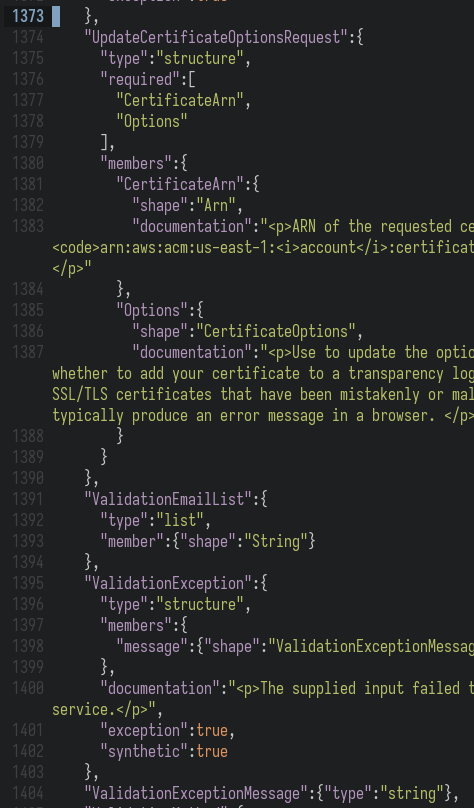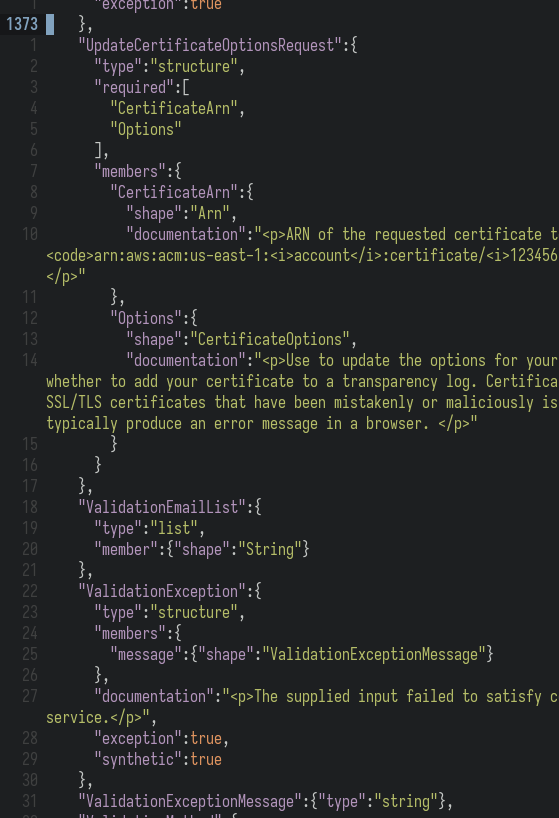I’ve been a vivid evil citizen in the world of Emacs for many years now. One of the must do settings in my opinion is, when using VIM keys for movement: Relative Line Numbers. It helps tremendeously with navigating multiple lines up and down, because you always see the amount of rows you need to move.
This sounds a bit cryptic so let’s visualize this in on an example.
Here is a code view with absolute line numbers:

Let’s say we are on line 1373 and want to change a type in line 1396.
We could just mash k a bunch of times (23 to be exact) or
we could input 23k once and be there right away. But with
absolute line numbers it’s not always easy to find out the number of
lines you need to move, without doing some math in your head.
This is where relative line numbers come into play:

Again we want to move 23 lines down. Do you see the difference? You
only need to read the number, where you want to go and input it before
j (up) or k (down). No need to distract two
numbers from each other in your head anymore. When skimming through code
you do this kind of movement several times in a matter of minutes. Every
time you just need to look at the number instead of doing mental
arithmetic. This adds up and will save you a lot of time over the
day.
Now that we know that this feature is useful, how do we get it in Emacs? Back in Emacs 23.1 linum-mode was introduced, which brought the possibility to have line numbers in a column to the left of the text. Before this Emacs showed you the line number you were in, in the mode-line at the bottom. But many modern editors made the number column left to the text a mainstream feature and so Emacs wanted to offer it as a feature as well.
To get relative line numbers with linum-mode you had to install a third party package called linum-relative, because the package itself never included it.
Fast forward almost exactly 14 years (Emacs 23.1 released on 2009-07-29) and linum-mode got obselete with 29.1 (Release Date: 2023-07-30). The reason was, that it was implemented in a hacky way and it made Emacs really slow when large files were open. Where do we go from here?
Introducing display-line-numbers-mode: This was a new built-in package shipped with Emacs 26 (Release Date: 2018-05-28) which should offer the same functionality as linum-mode without cracking down on large files. Basically linum-mode in fast. With Emacs 29 display-line-numbers-mode is not only an alternative to linum-mode, but it’s official successor.
And the best thing: it supports relative line numbers out of the box. That’s what got me excited. Solving an issue with built-in features instead of having to install more packages. Here is what we need to do:
(setq-default
display-line-numbers-type 'relative)
(global-display-line-numbers-mode)and at the same time we can get rid of this:
(global-linum-mode t)
(use-package linum-relative
:custom
(linum-relative-backend 'display-line-numbers-mode)
:config
(linum-relative-global-mode))This gives you the same exact functionality in Emacs 29 and above
with the new built in display-line-numbers-mode package as
linum-mode + linum-relative gave you. Another great
alternative feature display-line-numbers-mode offers is to set
display-line-numbers-type 'visual instead of
'relative. This gives you relative line numbers based on
visual lines instead of buffer lines. This means if a line is so so long
that it continues in the next line of your buffer (which your view,
where the file content is shown), 'visual counts this as
two lines instead of one, which 'relative would do. This
makes navigation even more precise. Especially if you work on code or
text with long lines a lot. That’s why I probably will also move further
to 'visual.
I hope this quicktip is of any help to you. I was first thinking of
introducing a new category bits with smaller bit sized
experiences than the normal blog post size of my past postings. But
looking at the text now and seeing what I ended up with, I will continue
to have these also under the normal posts.